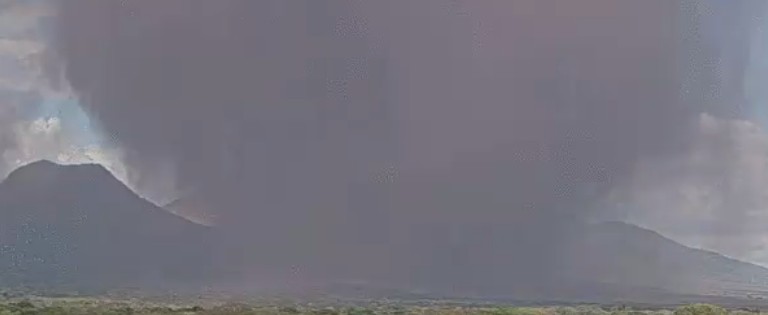San Cristobal volcano erupts, heavy ash blankets the city of Chinandega, Nicaragua

Nicaraguan San Cristobal volcano erupted at 19:26 UTC on March 9, 2021, blanketing the city of Chinandega and surrounding communities in ash.
Heavy ash emission lasted approximately 30 minutes, accompanied by deep rumbling. AFP reported cars had to switch on headlights as everything went dark.
Ashfall was reported as far as 17 km (10.5 miles) from the volcano.
Nicaragua Journalist Carol Altamirano said everything was grey… 'the crops of rice, sesame, vegetable gardens, fruit trees, and cattle pasture is covered in ash.'
Altamirano said farmers in the area had to cover their water sources and move animals to safe places. "In the city, people used umbrellas, caps, and face masks to shield themselves from the ash."
#volcan #volcano #SanCristobal Courte phase d’émission de cendres hier/Short sequence of ash emisison yesterday pic.twitter.com/UiRYzcv8Q5
— CultureVolcan (@CultureVolcan) March 10, 2021
AVISO:
Entra en erupción el #Volcán #SanCristóbal en #Nicaragua
Densa columna de gases y cenizas
Precaución se reporta intensa caída de cenizas.
Marzo 9 de 2021
Vía @cparlamentonic pic.twitter.com/D558enHF3u— Geól. Sergio Almazán (@chematierra) March 9, 2021
PRECAUCIÓN:
Densa caída de #cenizas sobre carretera Panamericana tras erupción del #Volcán #SanCristóbal en #Nicaragua
Marzo 9 de 2021
Vía @DanielkaRuiz25 pic.twitter.com/mOXsjQocsv— Geól. Sergio Almazán (@chematierra) March 9, 2021
#Nicaragua La cenizas expulsada por el volcán #SanCristóbal ha disminuido la visibilidad en #Chinandega.
Se llama a usar cubrebocas para proteger las vías respiratorias, cierra ventanas y cubre los recipientes con agua ante la ceniza.
Vídeo: @29Cheva_Patria pic.twitter.com/7JOWBfa7by
— EarthQuakesTime (@EarthQuakesTime) March 9, 2021
#INTERNACIONALES| NICARAGUA reportó que el volcán #SanCristobal en #chinandega hizo erupción dejando bajo fuerte cenizas los lugares aledaños, este volcán junto con el #Pacaya de #Guatemala han mostrado que el poder de la naturaleza es impredecible pic.twitter.com/WPuqQMUd37
— El Salvador Journal (@ElSalvadorJourn) March 10, 2021
The Washington VAAC said volcanic ash rose to an estimated 600 m (1 900 feet) above the summit, moving SW. It was very difficult to observe it on satellite imagery due to cloud cover.
On February 16, 2021, ash cloud from San Cristobal rose to 2.3 km (7 500 feet) above sea level and drifted SW. This was the first eruption at the volcano since March 4, 2019, when a gas-and-ash plume rose about 400 m (1 300 feet) above the crater rime.
Geological summary
The San Cristóbal volcanic complex, consisting of five principal volcanic edifices, forms the NW end of the Marrabios Range.
The symmetrical 1745 m (5 725 feet) high youngest cone, named San Cristóbal (also known as El Viejo), is Nicaragua's highest volcano and is capped by a 500 x 600 m (1 640 x 1 968 feet) wide crater.
El Chonco, with several flank lava domes, is located 4 km (2.5 miles) W of San Cristóbal; it and the eroded Moyotepe volcano, 4 km NE of San Cristóbal, are of Pleistocene age. Volcán Casita, containing an elongated summit crater, lies immediately east of San Cristóbal and was the site of a catastrophic landslide and lahar in 1998.
The Plio-Pleistocene La Pelona caldera is located at the eastern end of the complex. Historical eruptions from San Cristóbal, consisting of small-to-moderate explosive activity, have been reported since the 16th century. Some other 16th century eruptions attributed to Casita volcano are uncertain and may pertain to other Marrabios Range volcanoes. (GVP)
Featured image credit: INETER

Waiting also Campi Flegrei to do its job. By the way, volcanic ash is very good soil fertilizer, that’s why you have huge population densities in countries like Indonesia, Philippines, Mexico, Central America. (Plus Catholic Church of course).
Have you ever heard of a Volcanic Winter? The repercussions of such are totally devastating. Crops don’t grow, people don’t survive, animals don’t either. Such a scenario would bring about a whole lot of problems
If you want to make an omelette then you’re going to have to break a few eggs.
Yellowstone will do that, and in fact the injected ash will rise much higher
I keep on hoping for a monster volcano that can inject ash to over 50K feet (15.4 KM) and that would definitely put a dent in global warming.